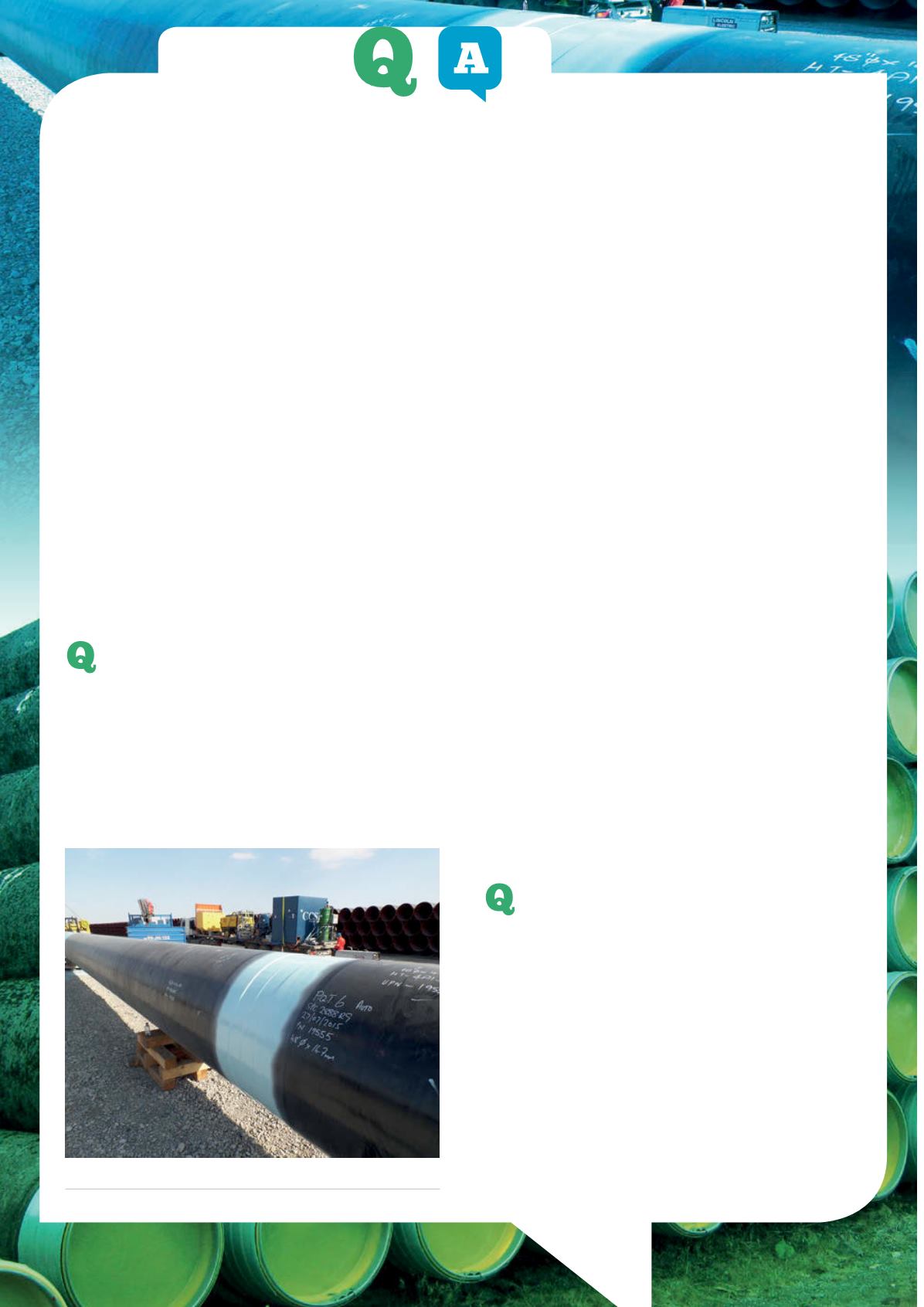
Coatings
&
overall coating cycle time by almost 80% using this automated
process.
The successful coating of inside diameter field joints,
particularly smaller pipe sizes, can pose certain challenges.
It is a difficult process to effectively clean, blast and coat
field joints that cannot be seen or reached by conventional
equipment and workers. As the industry increasingly demands
internal field joint coating, especially on horizontal directional
drill (HDD) pipelines and sour service lines, Aegion Coating
Services engineers and implements its own proprietary robotic
technology. With this technology, untethered robotic trains
are remotely guided up to 1000 m into the pipeline using the
latest telemetry transmissions. These robotic coating machines
are operated remotely by specialist technicians and perform
surface preparation, coating and inspection activities with the
aid of live video from cameras built into the robotic train. The
protective coatings of choice are typically either FBE or liquid
epoxy coatings. Once the inside diameter field joint is cured,
the same robots inspect the work to assure operators these
field joints are defect-free and coated to specification.
The field joint is considered the ‘weakest link’ during
pipeline construction, making coating a critical operation.
Combining internal and external automated robotic
technology allows pipeline operators to control pipeline
surface preparation, coating application and inspection
involved in this process.
Coatings for offshore pipelines
Despite project delays amidst low oil prices, deepwater
production expenditure is expected to increase by 69%
according to a report by global energy consultancy firm
Douglas Westwood.
1
Major growth regions including Africa,
Latin America and North America, collectively account for
approximately US$173 billion out of the overall US$210 billion
expected to be spent from 2015 - 2019. This increase is
believed to be spurred by maturing shallow water fields that
are driving exploration to more challenging frontiers such as
the Arctic and deepwater environments.
Thermal insulation coating is a key tool in a pipeline
engineer’s toolbox to help ensure that flowlines and risers
operate reliably in deepwater environments. These flow
assurance coating systems are applied throughout the length
of the pipeline except for the girth weld field joint section,
making application of a compatible insulating field joint
coating necessary during the pipeline construction process. As
deepwater developments increase in scope and quantity, so
will demand for high-performance deepwater pipeline coating
systems that can withstand design temperatures upwards of
150˚C and pressures surpassing 10 000 psi. Aegion Corporation
has responded to this by partnering with Wasco Energy to
construct a new Bayou-Wasco Insulation (BWI) pipeline facility
in New Iberia, Louisiana. This new facility allows the company
to service the Gulf of Mexico deepwater market along with
pipeline coating projects in Latin America and the Caribbean.
Flow assurance systems generally rely on syntactic and
foam polypropylenes, polyurethanes and epoxies. However,
trends indicate the current materials commonly used for
insulation purposes may not satisfy future deepwater pipeline
thermal and mechanical requirements. Deepwater pipelines
requiring thicker insulation coatings will pose challenges for
marine construction contractors during construction, for
instance field joint coating stress cracking failures during
pipelay. Pipeline installers have also expressed concerns
regarding the large field joint coating insulation equipment
footprint when operating on a barge or spoolbase that
is already limited in space. When lay vessel day rates run
into the hundreds of thousands of dollars, compounded
by the cost of operating in a low oil price environment,
according to Michael Surkein of ExxonMobil Development
Co., there is a “significant economic incentive to eliminate
the offshore pipeline field joint”.
2
Pipe coating manufacturers
and applicators must therefore reassess the materials and
application methods that are traditionally used to ensure
that field applied deepwater coating solutions also do not
contribute to cost overruns in increasingly ‘lean’ times.
Coatings repair and rehabilitation:
inspection, repair methods, testing
Rehabilitation of exterior and interior coatings can frequently
extend the life of a pipeline in a cost-effective manner. Old or
failing coatings can be located by various means. For piggable
pipes, inner diameter (ID) coatings can be directly observed.
For outer diameter (OD) coatings, corrosion engineering
companies like Corrpro can detect failures in coatings by
monitoring changes in CP current levels. Once failures have
been pinpointed, the rehabilitation process can begin.
For OD coating rehab, excavation is required. Once the
area is properly shored up, the rehab contractor begins by
removing the failed coating. Best practices recommend
complete coating removal followed by abrasive cleaning of
the substrate, however some clients prefer to simply abrade
the existing coating in order to save time and money. In cases
of badly disbonded coating, this cost-saving measure is simply
Figure 1.
Liquid coated joint.
50


